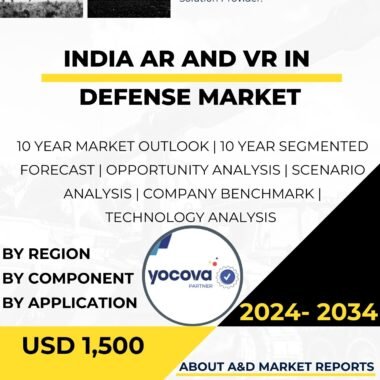Description
South Korea AR & VR in Defense Market
The South Korea AR & VR in Defense Market is a rapidly evolving sector that has the potential to transform military operations, training, and decision-making processes. AR and VR technologies offer immersive and interactive experiences that enable defense personnel to visualize, simulate, and analyze complex scenarios in real-time. This article provides an in-depth analysis of the current state, growth drivers, challenges, key players, and future prospects of the South Korea AR and VR in defense market.
The historical context of the South Korea AR and VR in defense market reflects the nation’s continuous efforts to modernize its military capabilities. As geopolitical complexities persist in the region, there is a growing emphasis on adopting cutting-edge technologies to enhance defense preparedness and maintain a competitive edge in the global defense landscape.
In the current landscape, the South Korea AR and VR in defense market encompass a wide range of applications, including training simulations, situational awareness, maintenance and repair assistance, and mission planning. Defense organizations are leveraging AR and VR technologies to improve operational efficiency, reduce costs, and enhance the overall decision-making process.
One of the primary growth drivers for the South Korea AR and VR in defense market is the country’s focus on innovation and adopting emerging technologies. As South Korea seeks to enhance its military capabilities, there is a growing recognition of the value of AR and VR technologies in providing a competitive advantage in the modern battlefield.
Moreover, South Korea’s strong information technology (IT) and electronics industry plays a crucial role in driving the adoption of AR and VR technologies in defense. The nation’s expertise in software development, advanced displays, and sensor technologies provides a solid foundation for the integration of AR and VR solutions into defense applications.
Furthermore, the South Korea AR and VR in defense market benefit from the nation’s commitment to indigenization and fostering domestic defense capabilities. The government’s support for research and development in cutting-edge technologies encourages the growth of homegrown AR and VR solutions, reducing dependence on foreign suppliers.
Additionally, the South Korean defense industry’s strategic collaborations with international technology companies facilitate access to advanced AR and VR technologies. Partnering with established global players allows for technology transfer and knowledge exchange, enabling South Korea to leverage best practices in AR and VR implementation.
The South Korea AR and VR in defense market also derive growth from the increasing demand for advanced training and simulation solutions. AR and VR technologies provide realistic and cost-effective training environments, allowing defense personnel to practice critical skills and improve their operational readiness without the need for live exercises.
However, the market also faces several challenges. One of the primary challenges is ensuring seamless integration of AR and VR technologies with existing defense systems and infrastructure. As defense organizations transition to adopting these technologies, interoperability and compatibility with legacy systems become crucial factors.
Moreover, addressing cybersecurity concerns is of paramount importance in the adoption of AR and VR in defense applications. As defense organizations rely on these technologies for critical operations and data management, robust cybersecurity measures are essential to safeguard sensitive information.
To address these challenges and ensure sustained growth, South Korea’s defense industry must prioritize research and development in AR and VR technologies. Investing in advanced engineering capabilities will enable the country to develop cutting-edge solutions tailored to defense requirements.
Furthermore, fostering strategic collaborations with international partners can enhance technological capabilities and provide access to broader markets for South Korean AR and VR solutions. Collaborating with allied nations fosters knowledge exchange and strengthens mutual defense capabilities.
The South Korean government’s continued support for the defense industry is crucial for promoting growth in the AR and VR market. Financial backing for research and development initiatives, as well as procurement programs, will drive innovation and ensure the development of state-of-the-art AR and VR solutions.
Moreover, promoting a skilled workforce and providing training and education in AR and VR technologies will enhance the local talent pool and create a sustainable ecosystem for the South Korea market.
In conclusion, the South Korea AR and VR in defense market is a rapidly expanding sector with immense potential to revolutionize military operations, training, and decision-making processes. Driven by the country’s focus on innovation, adopting emerging technologies, and enhancing defense capabilities, the market continues to grow steadily. However, challenges related to integration, cybersecurity, and competition in the global defense technology landscape require proactive measures from the government and the defense industry to ensure sustained growth and competitiveness. By investing in research and development, fostering strategic collaborations, and promoting a skilled workforce, South Korea can strengthen its position as a key player in the global AR and VR in defense market and enhance its overall defense capabilities.




